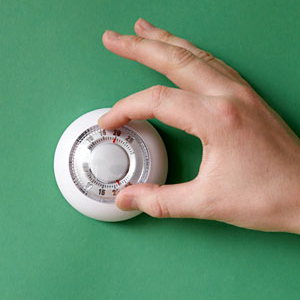
You can do it more economically if you learn some tricks about keeping energy costs in line. Many of the tips you hear are not really reliable and could be costing you money.
For instance, programmable thermostats. They really don’t measure up to the hype. And if you’re using a fireplace to supplement the furnace output, you may find the heat is simply going up the fireplace chimney. And despite the name, duct tape really doesn’t seal ducts.
According to a Chicago Tribune article by Gregory Karp, there really are ways to minimize heating costs, but they come from authentic sources, not product hype. He quotes Max Sherman, a scientist at Lawrence Berkeley National Laboratory.
Sherman is the one who conducted extensive tests on duct tape and found it is not a reliable way to seal ducts. Other tapes out-perform it, he found.
Among the words to the wise expounded by Sherman:
The ambience, aroma and traditional perception of the comfort of a fireplace do nothing to make that a good way to heat a house. The cost of paying for firewood, which most suburbanites must do, may eclipse the costs of natural gas. The fireplace has a healthy appetite for oxygen and doesn’t mind taking it from the warm air coming from the furnace if you combine heating methods. The only way to save money with a fireplace is to close off all the rooms except the one in which the fireplace is located.
Programmable thermostats do, at a cost, what you could do by simply walking over to the thermostat and changing it by hand. As the name suggests, they require programming and the result doesn’t always correlate with the need. Simple thermostats are just a clock that changes the setting on a timed basis. More complex versions may, for instance, turn up the heat in the morning on a day when you are sleeping in or are away from home. Hand-setting to meet real needs is preferable.
If you have widely varying temperatures where you live, a heat pump may have more difficulty responding to changes, Sherman said. Set-back can be difficult for the pumps and your savings disappear.
If you really want the convenience of a programmable thermostat, you must actually program it. The devices sell from $50 to $500 and vary in sophistication. You are responsible to understand your own model and use it to meet very particular needs of your home.
Sherman warns against cranking up the heat to an abnormally high temperature as a first step to heating the house. Setting the thermostat abnormally high will only waste costly energy. He suggests thinking of the furnace as a light bulb. It is either off or on and upping the temperature will not make it any more “on.”
Maintaining a constant temperature, whether you are home or not, is not a good approach, despite claims to the contrary. If the furnace is on, it is using energy. He advises setting the temperature at 68 degrees and turning it down for sleep times and when you expect to be away for awhile. You can save up to 1 percent per year on your heating bill for each degree you set the thermometer back for eight hours, he said.
If you expect that such steps as installing more efficient windows will lower your heating costs, consider first how much you pay for the new windows. It could take a long time before there is any savings over the investment, Sherman says. Windows come behind sealing, insulation and system efficiency improvements in the list of things you can do to improve your energy situation. But if you want to change windows for aesthetic reasons, be sure the replacements are energy-efficient. Cheaper and ultimately more effective steps include sealing gaps and cracks around windows, doors, ducts, pipe cutouts and other areas that are conduits for cool air. air. Blowing sealant into ductwork (aero sealing) is effective, although initially expensive. A professional energy audit may be worthwhile, although it will cost from $250 to $800.
Least expensive among the steps to lower energy costs are the simplest: Put on a sweater and slippers during the day and use more bedding or an electric blanket at night.